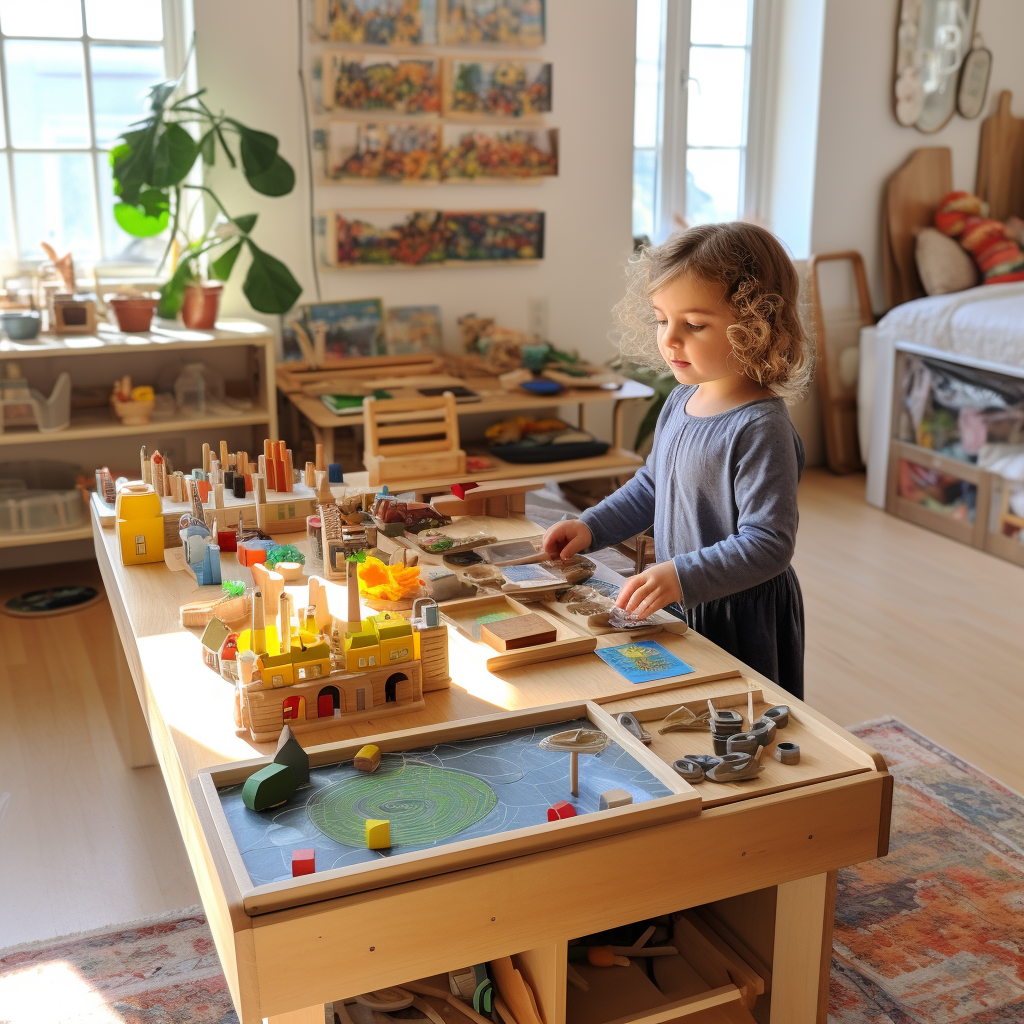Centuries after Dr. Maria Montessori first engineered educational environments nurturing child development we now know as Montessori models, neuroscience upholds the effectiveness of her core theory – human beings thrive through purposeful spaces elevating natural growth trajectories.
While formal Montessori schooling remains limited, especially affordable access, parents worldwide adapt aspects introducing Montessori principles at home enriching kids of all ages.
In part one we survey core Montessori philosophies around independence, environmental order, aesthetics impact and developmental appropriateness when designing children’s spaces intentionally whether nurseries for babies or personalized bedrooms conducive to concentration for grade schoolers.
In part two we offer detailed suggestions arranging furniture, organizing storage plus curating decorative and activity elements across bedroom and common living areas bringing Montessori advantages home through thoughtful space preparation, routine planning and tools simplifying intuitive learning kids crave.
Part 1: Applying Core Montessori Tenets to Home Design
Uphold Child Independence Whenever Possible
Core to Montessori remains upholding dignity in children – conveying respect, granting responsibility and expecting participation as capable beings from infancy onward. Assume independence likely beyond ages conventions dictate. Provide infants floor freedom exploring without restrictive devices like stationary bouncers. Introduce silver toddler utensils and open cups minimizing assistance eating. Store toys on low shelves facilitating baby and toddler choice. Follow their interests. Children gain confidence and capability when adults model patient trust.
Ensure Orderly, Clutter-Free Spaces
Montessori models maintain light yet deliberate environmental touch conducive to concentration. Too many loud colors, textures and competing accessories overstimulate senses fragmenting exploratory flow. Anchor rooms in neutral backdrops like white walls then layer subtle color accents through drapes, pillows and artwork little hands can touch WITHOUT teaching “look but don’t handle” restraint. Keep floors, surfaces and storage bins tidy through consistent habits not stressful purging. Model repairing then responsibly preserving quality tools and materials enjoying their purpose. Guard against accumulation too soon outgrowing children’s reasonable usage and comprehension. Seek joyful usefulness over chaos.
Prioritize Durability & Nature-Based Materials
Since young children learn through sensory exploration more than verbal directives alone, ensure they access household environments safely but freely. Select child-sized tableware resistible to drops for self feeding skill building. Choose solid wood furnishings over plastic units unable to endure years of exuberant use. Seek out natural fabric bedding, baskets and washable rugs instead of composites off gassing indoors. Surround children in authentic durable items supporting independence over meaningless bright gimmicks claiming developmental advantage. Materials matter tremendously shaping early cognition – so choose substances wisely.
Showcase Beauty Supporting Development
Young minds detect visual patterns long before decoding words on pages so decorate child spaces leveraging shapes, colors, textures deliberately. Coordinate baskets or frames showcasing treasures discovered outdoors fostering nature connection. Introduce fine art conversationally – what characters or creatures emerge from abstract strokes? Display global cultural items as conversational launchpads more than rigid geography quizzes. Frame a welcoming picture over toddler beds conveying rest, space to gaze during diaper changes or quiet cuddles nurturing developmental bonds non-verbally. Thoughtfully curate visual nourishment feeding souls.
Engineer Spaces Respecting Developmental Needs
Study Maria Montessori’s child development stages undergirding her educational approach when designing home spaces or selecting activity materials. Provide infants (newborn to one year) ample floor time building core strength, sensory exploration through high contrast mobiles plus baby-safe mirrors. Display images at eye level.
Toddlers walking through eighteen months old yearn stacking toys aiding coordination, cause-effect play plus vocabulary building through picture book sharing. Replace baby bins with accessible shelves storing treasured items.
Let two to four year olds attempt carefully supervised woodworking like sanding small boards or transferring objects between containers improving focus and purposeful movement. Sturdy washable toddler furniture sets serve well.
For children four to six, introduce more precise hands-on learning across practical life skills like food prep, fabric care, cleaning routines guided stepwise by patient adults scaffolding concentration and work ethic through repetition establishing foundational habits to thrive.
Part 2: Actionable Steps for Montessori Inspired Home Arrangements
Bedrooms as Personal Development Havens
Children spend extensive time inhabiting bedrooms as personal sanctuaries so design details greatly impact capability and confidence. Safety always comes first yet rooms anchor healthy growth beyond preventing just bodily harm. Apply Montessori bedroom decor wisdom establishing spaces kids flourish within now and for years ahead:
Infancy
Hang non-toxic, high contrast black and white mobiles with gentle music box attachment over cribs developing visual tracking plus auditory discrimination essential for language acquisition. Secure mirrors for self discovery without loose shards. Select cribs convertible into floor beds for mobility building muscle strength.
Toddlerhood
Curate cozy floor beds surrounded by baskets of board books, soft fabric balls and open-ended wooden toys like waldorf block sets or ring stackers encouraging manipulation. Maintain organized, minimal storage for early toy rotation. Display playful art visually opening imagination.
Preschool Age
Add child-sized tables, stools and focus accessory like easels for art plus introductions to more precise hands-on exercises like wood polishing sets or sewing cards improving concentration and coordination. Display rotating nature collections in simple frames sparking wonder.
Early Elementary
Keep workspace clear for projects, crafty exploration and displayed books inspiring independent reading now critical for growing intellects. Add floor cushions for peer collaboration. Introduce calendar schedules, egg timers etc facilitating self management around homework, household contributions and self care routines.
Throughout the years anchor bedrooms in what children developmentally require for extending independence successfully. Then observe their ever evolving interests filling space accordingly.
Playroom Libraries Fostering Discovery
Playrooms treasure child development unlocking cognition potential through activities well sequenced with age. Carefully curated rooms supply physical, intellectual and emotional spaces adventuring critical learning windows:
Sensorial – Display natural items like wood slices, stone pebbles, leaf/bark rubbings isolating comparison concepts – heavy/light, smooth/coarse surfaces. Add scent vials correlating smells with memory.
Auditory – Rotate musical instruments like xylophones, rain sticks, clackers with increasing complexity exploring sound discrimination.
Visual – Build collage stations with maps/sticker books reinforcing spatial geometry. Add color mixing activities like droppers above wet paper towels blending colors.
Language – Display books across reading levels self accessible on low shelving with cozy seating nearby. Add tactile letters, magnet boards and writing stationery reinforcing pre literacy skills.
Mathematics – Include abacus bead bars, number puzzles, building blocks graded by size, calendar displays with manipulation tracking introductory arithmetic concepts.
Above all create peaceful playroom atmospheres untouched by modern tech screens those isolation gadgets waiting until foundations build sturdily through multi sensory analogue play.
Shared Family Spaces Promoting Responsibility
While children benefit immensely from rooms specifically tailored for development through toys and tools littering floor space freely, shared common areas necessitate heightened responsibility and care beyond their own quarters. Guide children productively participate in household living spaces using designated storage, family contribution systems and chore demonstration.
Kitchen
Display aprons suiting young chefs beside durable dishware perfect for mixing practice. Assign snack-prep stations at kid height. Introduce recipe flowcharts and measuring cups/spoons for math skill practice.
Dining Area Set open shelving with baskets holding cloth napkins and non-breakable dinnerware for self setting places. Add centerpiece vase kids take turns arranging flowers within.
Living Room Devise simple organization scheme toy baskets/shelves easily returned when play concludes. Uphold gentle handling of displayed family mementos. Schedule brief tidy ups mid play restoring order.
Mudroom Low coat hooks accommodate little hands. Baskets store shoes. Simplify key hooks and visual reminder systems aiding memory so kids shoulder preparation tasks before outings responsibly.
Bathrooms
Step stools support independent hand washing and bathroom hygiene expanding self care skills. Guide children assisting wiping fixtures, sink/tub cleansing and putting fresh towels out post bath times.
Shared family areas nurture responsibility beyond playrooms when children participate in household care realistically. Align child-sized storage spaces and household tools appropriately then demonstrate patience allowing time needed slowly achieving mastery kids beam proudly sharing with others!
Establishing Routine Rituals Reinforcing Rhythms
Montessori schools intricately design daily and weekly flow through consistent classroomcommunity rituals balancing sequenced learning plus free exploration. Families flourish instituting household rituals conveying connection while empowering independence simultaneously.
Morning Routine
Display simple visual morning checklists kids follow transitioning smoothly into days – make bed, brush teeth and hair, get dressed, prepare backpack. Calm breakfast conversation and regular departures ground successful school readiness habits.
Afternoon Welcome
Demonstrate reflective training asking kids share favorite and more challenging daily moments before screen or snack time. Guide children unpack backpacks independently, transitioning locations to decompress with movement.
Evening Power Down Ritual
Protect peaceful pre-bedtime space restricting digital stimulation after dinner into pajama, book reading and bedtime self care sequences leading to restorative rest. Model calmness powering down home atmosphere.
Regular family gatherings reinforce tribal belonging and healthy communication habits amid abundant solo choices facing modern children. Simple routines foster responsibility and life skills mastery freeing parents overwhelmed trying coercive control approaches alone.
Weekly Jobs Chart
Post family responsibility bulletin board with rotating child chores like meal prep, living room cleaning, laundry folding, yard care etc facilitating ownership through household contributions appropriate by age. Guide children’s steady participation gaining competence and empathy.
Entrusting children uphold family environments teaches resourcefulness, time management and nurtures budding executive function exponentially.
Montessori At Home – Principles for Parenting Peace
Over fifty years since passing, Dr. Maria Montessori’s education revelations continue proving timeless – align learning environments with developmental instincts and children beam meeting their spectacular potential without us trying to force mold it.
While formal Montessori schools remain limited, especially cost prohibitive for most, her core theory around upholding child dignity through calibrated independence and carefully prepared surroundings transfers into parenting and home design gracefully when we shed assumptions around what young minds “must” learn by when, how much control works “best” and where their capabilities likely plateau without rule.
Raising peacemakers and partners eager to collaborate rather than control seeking creatures involves much modelling when actions speak louder than these words. But heeding neuroscience suggests improved trajectories exist from infancy onwards simply through environment upgrades that still grant freedom to move, choose and self construct within thoughtful spaces signalling – this home believes in you growing at your natural pace!
Our role remains planting seeds then marveling at diverse blooms unfolding through each miraculous child when we water carefully around (not on top of) their unique developmental soil. All families might then witness their brighter capabilities when, as Maria Montessori trusted, kids truly construct themselves.

